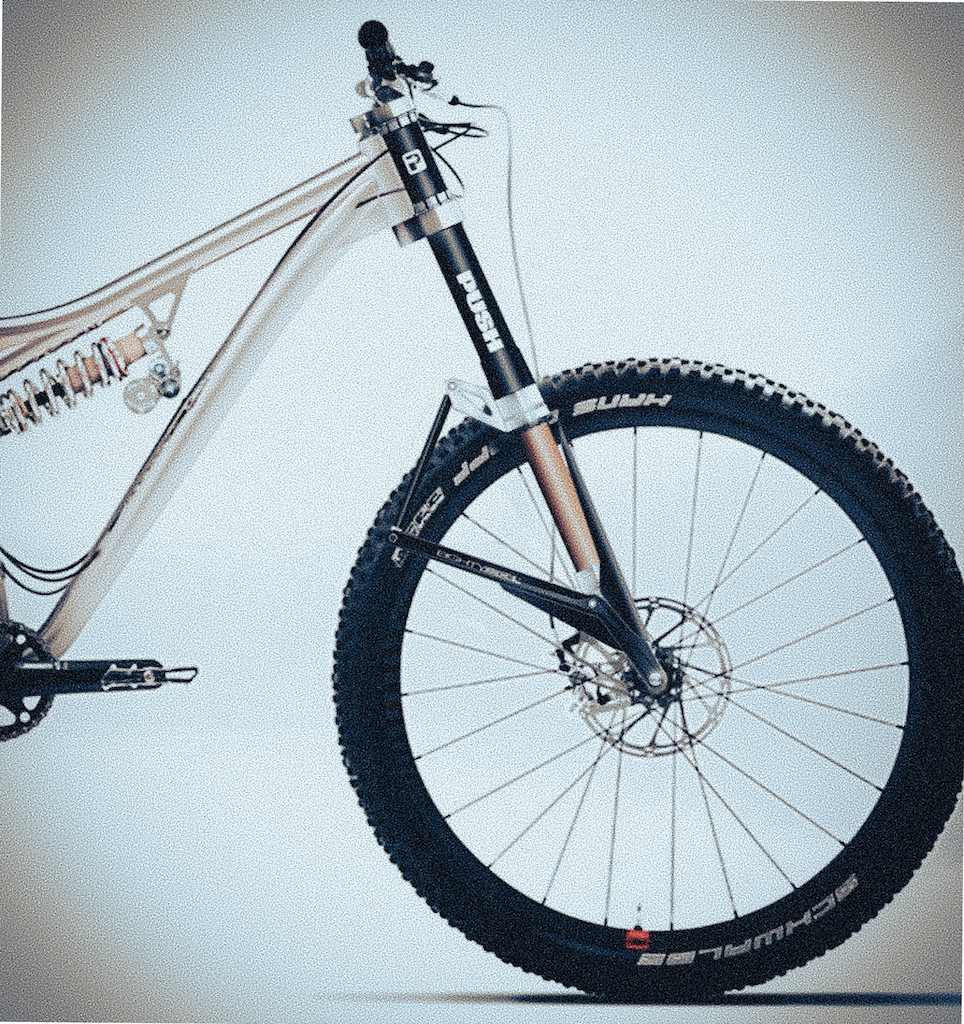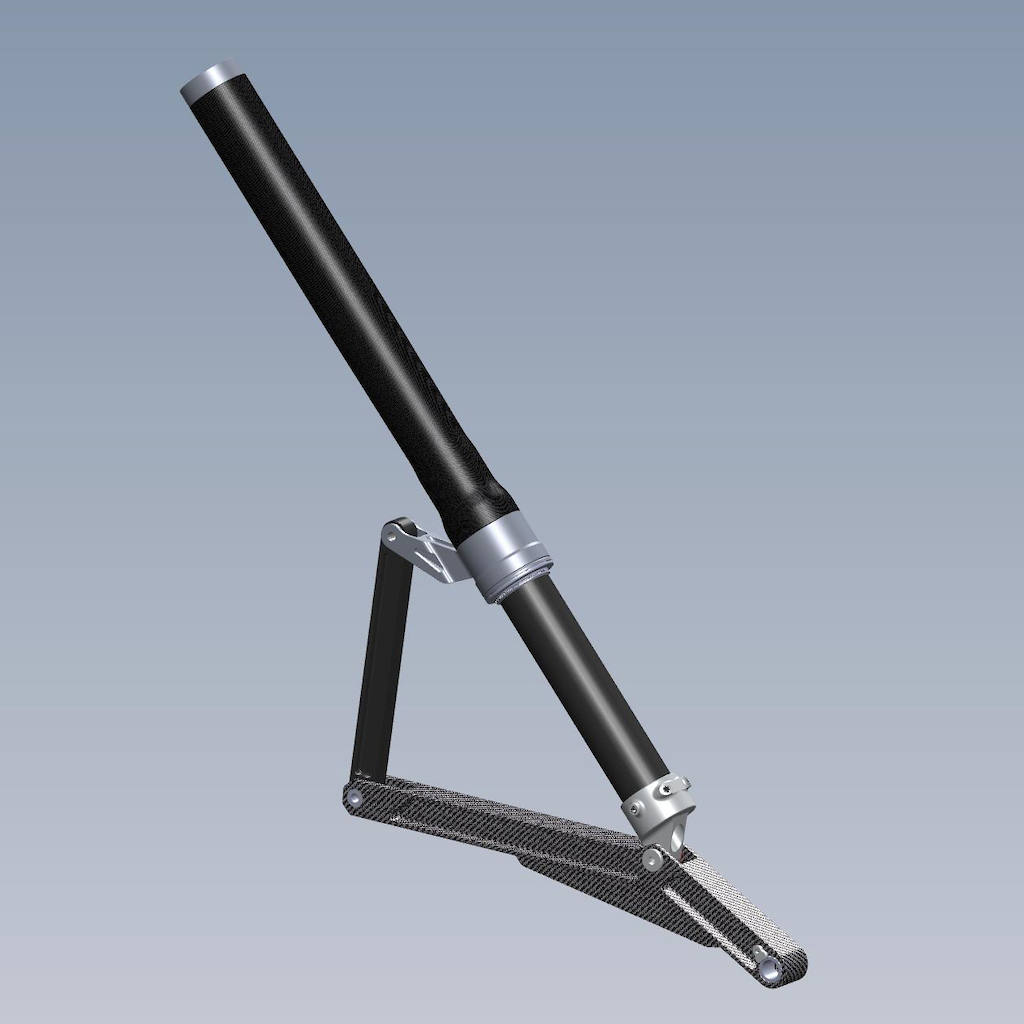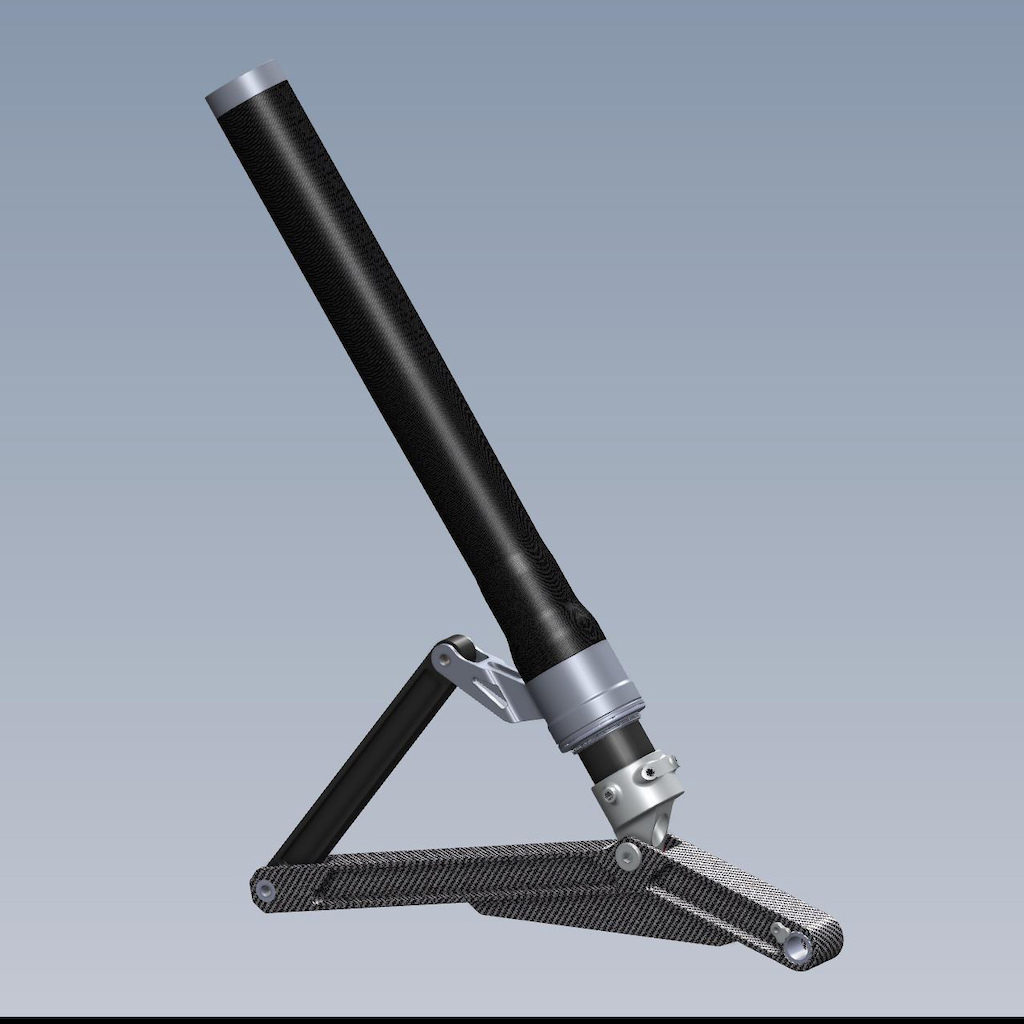The Story Behind Push Industries' Prototype Linkage Fork
When a grainy photo of a linkage fork appeared on Push Industries' Instagram account a few weeks ago, it caused a bit of a buzz around the industry, in part because the news of Specialized's acquisition of Trust's linkage fork patent came out just a few days prior. There have always been those homegrown trade show contraptions or student engineering projects that appeared on the slopes of Whistler Bike Park, but for these names with a lot of clout in the bicycle biz, it made us think. With their ability to dictate axle paths and anti-rise characteristics, are linkage forks the future of mountain bike suspension technology?
Push Industries has been well known for their tuning and aftermarket kits for some time, but when they introduced their ElevenSix shock, it raised the question - what comes next? Building a rear shock is easy. Simply throw a block of aluminum into the CNC machine, pop in your favorite shim stack, slide on a suitable spring, and voila. Sure, there's A LOT more to it than that, but a fork on the other hand takes a large investment magnesium cast, that is, if you build a traditional fork with one-piece lowers.
It might look like a desktop daydream, but Push actually began prototyping the fork you see above in late 2015. The inverted, dual-crown chassis is also linkage driven. Based on the Earle's Fork patent, used on BMW motorcycles from 1955 to 1969, the leading link design features a link arm main pivot that rides on the lower leg while the dropout is attached separately. Behind the stanchions is not a fender, but another arm bridging the link to the upper tubes.
If you can imagine the front axle moving from the 5-o'clock position up to 3-o'clock, then you understand one concept of the Earles fork: a lengthening wheelbase. The prototype also tested anti-rise levels that are induced by the brake forces, but unlike traditional forks, it can cause the front end to rise under hard braking. USD forks are susceptible to lateral deflection, but the Earles concept helps to stiffen up the steering.
We reached out to Darren Murphy at Push to see if we could get more info on this early design:
Plenty of riders appreciated the qualities of their Trust linkage forks and I would have loved to try out the Earles concept fork myself. I'm certain Darren and his team learned a lot through that development process, tangible projects aside. So, does that mean we will see another fork prototype from PUSH and what will it look like?
When we prodded Darren more about the idea of a production fork, he was tight lipped about the chassis construction, materials used, and a timeline, but did go on to say:
Author Info:
Must Read This Week
Sign Up for the Pinkbike Newsletter - All the Biggest, Most Interesting Stories in your Inbox
PB Newsletter Signup





Either way, good to see brands pull old expired and unused patents from the mothballs and actually do something with it. Looking forward to the day that a brand just picks that old PeteSpeed gearbox patent that Hayes bought from B1 and never did anything with. Could easily be the cheapest internal gearbox that people have been waiting for.
Almost went with Trust just as they shut so hanging tight for now.
Oddly enough, the Message (and Shout I assume) moves in a mirror image to this.
Hence this could depending on configuration:
* Keep wheelbase from reducing much
* Maintain wheelbase
* Grow wheelbase through travel
@ironxcross comparing rear axle path on the rear suspension with a telescoping fork and a linkage fork is quite complicated.
A rearward rear axle path actually increases bike stability because the wheelbase increases length while going through the travel. A rearward front axle path decreases bike stability conversely.
The steering makes the front extra tricky because while the bike may be more stable the steering may become more or less sensitive at the same time. This depends on trail.
Hence the devil is in the details and you can't just say "rear is always better".
The Trust Message changes trail through it’s axle path.
1. 100% anti-dive. Telescopic forks have roughly -30% anti-dive (30% pro-dive), so there's no need to go all the way to 100% AD, especially when high AD introduces other issues.
2. Rearward axle path. A linkage - especially one without any telescopic elements - reduces friction so greatly that even a more vertical axle path can transmit less force to the rider's hands. In the case of the Trust forks, their axle path was too rearward (initially), leading to poor compliance.
3. Weird motion ratios. For rear suspension, a lot of R&D has gone into developing a narrow range of spring and damper curves that work with a narrow range of motion ratio curves. Many linkage forks have used wildly different motion ratio curves and either attempted to couple them to equally wild spring and damper curves, or just used traditional spring and damper curves and hoped for the best (spoiler: the former rarely works and the latter never works).
The challenge with designing front linkages is to balance all the parameters, of which there are many more than with a telescopic fork, and there's a lot less R&D to draw upon as a template.
It becomes even more complicated if the linkage is integrated into the chassis, as opposed to plugging into a standard head-tube, but the potential for performance is even higher.
Fantastic breakdown!
• Is it constant in heave or pitch? Can't be both.
• Why should it be constant? Maybe there should be less trail at full extension, for lighter steering feel under light loads, and more trail when compressed (again, need to discuss heave vs. pitch) for more stability when you're really getting after it.
The former shows a poor understand and/or poor communication of dynamic chassis parameters, and the latter hasn't been fully explored because the R&D on linkage forks is so much less than that of telescoping forks.
I need to come clear- I’m building a new Tallboy and I’ll be using a Trust Message fork.
As my handle implies, I’m and ex motorbike racer, and I’m always looking for a way to get my low travel bikes to handle like a motorcycle. Low travel because I climb out of the saddle, so I feel the anti-bob of the Message kinda offsets the weight.
My downhill style is extremely loose at the bars, so I’m hoping the harsh ride won’t be as much as an issue.
Everything else about it sounds perfect, and they can be had barely used for under $700!
30% pro-dive for telescopic forks? I thought is was more like 90% pro-dive? I’m just going from memory though and could well be wrong.
Have you seen this?
In a different thread he states that at full extention its got more trail than a conventional fork and compressed its got less.
thumpertalk.com/forums/topic/1299008-hossack-and-girder-telescopic-fork-hybrid-suspension
@englertracing: I'm a fan of independent-axes systems, such as the Hossack, which is what I prefer for my own designs. Can't say I favour the hybrid, though - why have two complete systems when all design goals could be achieved with just a Hossack? In any case, I favour trail increasing with compression for mountain bikes because mountain bike chassis are often pitched forward during descending, which is when the handling is most vulnerable to instability. When the lower steering axis (fork) is independent of the upper steering axis (stem), it's possible to have increasing trail while preserving front-centre length.
Also ... I made a mental error. I was recalling one of my front linkage configurations that had 30% less dive than a telescopic fork at a certain point in the stroke. That configuration had a little pro-dive at full droop to allow some weight transfer and "soften" the brake force, therefore the tele fork has more than 30% pro-dive at full droop. Apologies for the error. The tele fork isn't as bad as 90%, though.
There will be more pro-dive on a fully extended telescopic fork with a slacker head-tube angle, longer wheelbase, and/or lower centre of mass, so a motocross bike could have an extremely high pro-dive value. I don't know the combined CoM location precisely enough to say whether a motocross bike has 90% pro-dive at full droop, but it could be possible.
So does this change that ?
But does seem some errors with this linkage design for it to work?
@aljoburr: Moving the axle forward does not increase the head-tube angle, it increases the offset, which reduces trail.
As for my initial figure of around 90%AD- I have now realised that you were right and that value was more attributable to motorbikes with their lower CoG. A gravity-focused mtb at full droop with rider in a neutral position (whatever that is!) is likely to be closer to 60%AD* (back of an envelope workings out)
I also agree with you that a linkage fork would be better with some pro-dive or at least 0% AD (at sag?) if only to provide a familiar feeling to the rider. It will also help reduce ground trail that may be beneficial with initial cornering turn-in.
You're correct that a more familiar feeling is initially welcomed by most riders, but maybe optimial performance could come from a bike that feels less familiar. Just as a 2021 bike would feel alien to a 1990 rider, maybe the "ultimate" linkage front end would require adaptation. Maybe tire design could change a little to modify the initial braking and turn-in properties, affording more room to optimize the fork kinematics. There are so many variables and there is so much room for optimization, especially with linkage forks that use decoupled steering axes.
In the case of Cathro and Minnaar, I think the pieces were in place to achieve nearly modern performance, and the limiting factor was the boldness and patience for riders and manufacturers to get far outside their comfort zones and test radically different bikes. There may have also been some differences in DH courses that didn't favour increased stability as clearly as current courses, but I don't think that's a sufficient explanation, as 2000s DH courses weren't any more slow and janky than modern enduro courses. Maybe a full-on modern DH bike would've been slightly overkill for the courses of the time, but modern enduro bikes aren't far off modern DH bikes.
I think the slow progress was due to evolving the design by 5 mm here and 0.5° there every 3- to 5-year product cycle. Almost no companies bracket with their design changes by going too far, then dialing it back to find the optimum. The development process usually involves making a change, observing that it's better, and just going with that, without exploring whether if some was good, maybe more would be better.
As a point of interest, I have a custom 2006 Iron Horse Sunday that was built for Sam Hill, but incorrectly made with the longer seat-tube (he ran a size Large front triangle with a Medium seat-tube). The head-tube angle is about 60.5° or 61° and the Large was unusually long for the time. The geometry is similar to the current Specialized Demo, with the smaller wheels and slacker head-tube angle creating a similar trail value. Everyone who rode it immediately knew it was different and I absolutely loved it. If I rode someone else's bike, I couldn't get off it fast enough! It was obvious that every off-the-shelf bike was simply wrong and the solution was as easy as changing the mitre angle, yet no one tried it. That said, it was a very different riding experience: the bike didn't feel like the right tool for the job until I was riding nearly at my limit, so maybe not every customer would've been into that.
Like this?
www.pinkbike.com/photo/17994253
I know some of the reasons did not finish building up, but most just in my own head
But should dig it out & at least ride it !
Here is something of interest, did you know that hydrogen gas can be extracted using very low energy from sewage water?
Not my research, but very important all the same!
Wonder how long will take, before they stop dumping it in the Oceans?
www.youtube.com/watch?v=LaT5PZixcV0&t=2s
motochassis.com/product/front-suspension-software
You’re welcome.
He, Hossack, Fior, Valentino Ribi Saxxon, Leitner , Andre De Cortanze and a fair few others have made great "funny front ends". BMW, notably, have made use of at least 2 of said designers. Without, if I recall correctly, financial recompense.
A good thing to look up, for those not familiar, go looking for Ribi Quadrilateral Forks - multiple pictures are just a few 'clicks' away. Their progression, from his own start, notably tried and raced by Roger De Coster on his RN Suzukis, to the various Honda incarnations of it, is quite the thing. Honda bought the rights to it through DeCosters' insistence. It's an example of making a beautiful, but incredibly complicated - some variations with more than 20 pivot points - front end, to attach to a 'normal' steering head frame.
In strict Engineering terms, Telescopic Forks are quite the "Engineering Abomination".
But, bloody hell they can, and so many do, work well. In so many applications.
Many of the designers of Funny Front Ends (FFEs), have come out with "we need the riders brought up on Telescopic Forks to Die Out", due to how used we are to them. The best ( well, the most accepted) "Funny Front Ends", have been made to closely duplicate the actions / geometries / paths of Teles - that perhaps goes back to the FFE designers wanting the 'passing' of riders.......
The biggest mistake made with so many FFEs, is strictly adhering to The 'Perfect' Engineering and Design an FFE can give you. Resulting in truly strange / disconcerting performance, despite their 'correctness' of design. The multiplicity of bearings / pivot points ( and the precision needed for those multiples, and wear / 'play' they can / will have, Plus (moments of) Inertia of so many of the designs, can present problems to rival, or exceed, the inherent problems of Telescopic forks.
"Funny Front Ends" - I like Many of them. And, despise some of them. Done well, they can work well. Done badly, they can be dreadful. Just as "Engineering Abomination" telescopic forks can.
It will be interesting to see what PUSH eventually do have as a front end, to sell.
I think Dave 'trust fork' though would be more interest, but turns out demands re-education & even all governments round the world working together are struggling to pull that one off?
It’s a shame that Pinkbike had an E13 Motion Ride fork in their hands for a demo and never got around to riding it; they had it for a while apparently
I followed the hype and tried an 11/6. Set it per their recommendation and it was ok, lots of cool knobs turn. But for the price and weight it needed to be better than ok. Sold it still running air Fox.
Always thought the Trust forks were cool and interesting, but at the end of the day paying more to add weight to my bike when the current traditional forks perform so incredibly well is just impossible to justify. If I were them I'd be very please to cash out on the patents and move on.
Clearly we are all used to a straight “linear” look to our fork. Bike forks have been straight for years, but if we look at the evolution of rear suspension, there’s nothing straight except in a rigid frame.
Aesthetics guiding design is a terrible way to build a better mousetrap.
I just bought an E13+ Motion Ride fork. I had demoed one a few months back, bought a telescopic fork instead and have not been satisfied, so I ordered my own earlier this week.
Having extensive ride time on the Trust Message and Trust Shout, I’m a confirmed linkage fan, but like all things there are pros and cons.
I think it's kinda sad that aesthetics is a guiding principle, if anything, using aesthetics as a value has limited innovation, as a result most people ride a dated and inferior front suspension.
I’d love to see a Push linkage fork, but from a business standpoint it’s probably a bad idea ( see above comments).
keyassets.timeincuk.net/inspirewp/live/wp-content/uploads/sites/11/2018/10/hubmarket-3433-0-66710600-1357719263.jpg
Wouldn’t need for my riding style
Works well on my bmw motorcycle
youtu.be/39GdUOrmx3c
www.cycleworld.com/honda-gold-wing-mainstream-motorcycle-without-telescopic-fork
www.cycleworld.com/story/bikes/gold-wing-style-forks-for-future-hondas
i.pinimg.com/736x/dc/0d/cb/dc0dcbeb5047702d19898afb32f43c0d.jpg
that ends up looking like this:
www.motion-ride.com/en/16-125-motion-e-18.html?sld_id_country=8&SubmitCurrency=1&id_currency=1
Pretty wild stuff huh???
I ride one, good fork, better than a Trust.
Those don't match up. Stiffening the steering would come mostly from torsional stiffness, not lateral stiffness.
classicavenue.com/product/1969-sachs-125cc
bikeco.com/trust-message-fork-review-geometry
Ignoring the chain-driven antisquat and steering dynamics that come into play with MTB, it’s possible that the best suspension performance would come from perfectly vertical travel front and rear, more or less like a car. Then our wheelbases are remaining pretty much constant despite what either wheel is doing in terms of suspension.
You can maintain constant wheel base and have reward axle paths. The two aren't mutually exclusive.
A vertical axle path may be good for chassis dynamics, such as front end dive, but will perform worse when it comes to traction and comfort. This design makes sense for a motorized street bike, but not an off-road MTB.
True! But I missed mentioning in my statement the real crux of my argument —- more vertical paths would maintain wheelbase AND relative weight distribution.
Although to be fair, all model of MTB chassis dynamics under compression seem to be oversimplified and flawed - like the Trust idea of maintaining trail. During a square edge bump hard compression, your contact patch is probably way forward of normal, and during rebound way behind. How do flat-ground measurements of trail matter at that point?
Also, better get used to gearboxes because they're coming and i'd be surprised if they don't become the new standard.